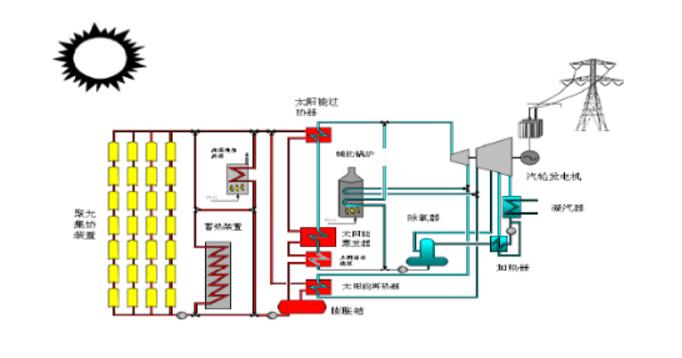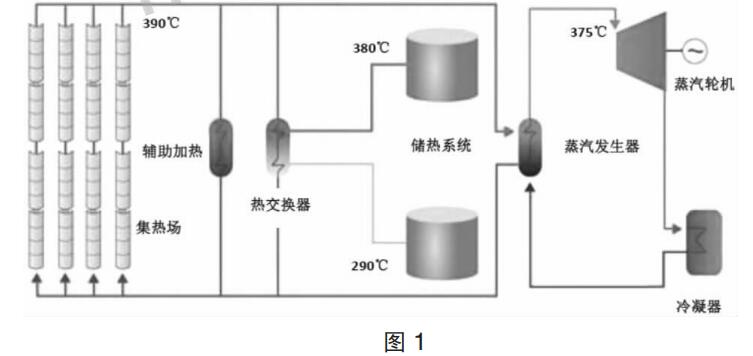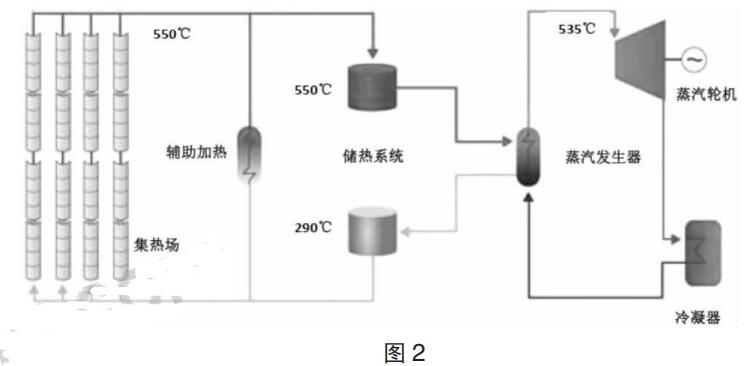The trough solar thermal power generation system is called a trough type parabolic reflector solar thermal power generation system. It arranges a plurality of trough parabolic concentrators in series and in parallel, heats the working fluid, generates high-temperature steam, and drives the turbine generator unit to generate electricity.
Trough solar thermal power generation utilizes trough parabolic reflectors for solar thermal power generation. It is a large number of parabolic trough concentrator collectors, arranged in series and in parallel, which can collect higher temperature heat, heat the working fluid to generate steam, driving turbine generators to generate electricity. Trough type solar thermal power generation mainly consists of four parts: mirror field, heat exchange system, heat storage device and steam turbine power generation device.

The traditional solar trough type solar thermal power generation system technology (as shown in Fig. 1) is a heat carrier represented by heat transfer oil. It utilizes the optical principle of parabolic light to gather solar energy, and then collects solar energy on a heat collecting pipe. The heat transfer oil in the heat collecting pipe is used. It absorbs the energy of the sun. The heat-conducting oil will be gradually heated from 290°C to 390°C during the flow of the solar heat collection field and then flow out of the solar heat collection field. A part of the heated high-temperature heat-conducting oil flows into the steam generator to exchange heat with the water, and then flows back to the solar heat collecting field. The heat-exchanged water turns into steam at 375° C. to drive the steam turbine to generate electricity; the other part of the high-temperature heat conducting oil passes through the heat. The exchanger exchanges heat with molten salt and flows back to the solar heat collecting field. The high-temperature molten salt after heat exchange will be stored in the high-temperature molten salt tank. When there is no sunshine at night, heat exchange with the heat-conducting oil is used for power generation of the steam turbine at night.

The new-generation solar trough solar thermal power generation system technology (see Figure 2) is a heat carrier represented by molten salt. It uses the parabolic optical principle to collect solar energy and then collects the solar energy on the heat collecting pipe. The salt absorbs the energy of the sun. Molten salt will gradually heat up from 290°C to 550°C during the flow of the solar collector, and then it will flow out of the solar collector field. The heated high-temperature molten salt flows into the high-temperature molten salt storage tank in the heat storage system. A part of the high-temperature molten salt flows out of the high-temperature molten salt storage tank, where the steam generator and the water exchange heat, and then flows back to the heat storage system. In the low-temperature molten salt storage tank, the heat-exchanged water becomes 375°C water vapor to drive the steam turbine to generate electricity; the other part of the high-temperature molten salt is left in the high-temperature molten salt and stored in the high-temperature molten salt tank, and is continued when there is no sunshine at night. The output heat transfer is used for steam turbine power generation at night.

From the discussion of the above two technologies, we can see that there are mainly three differences in the new-generation solar trough CSP technology.
First, a new generation of technology directly uses molten salt instead of heat transfer oil as a heat carrier. The price of molten salt is generally about 1/6 of that of the heat transfer oil, so that the cost of the entire power plant is greatly reduced, and the molten salt is not explosive. The use of heat transfer oil as a heat carrier reduces the level of fire protection and explosion protection of the entire solar thermal power plant, reducing the accident rate and reducing the purchase cost of power plant pipe and valves.
Second, the use of molten salt for direct storage eliminates the need for secondary heat transfer, which reduces heat loss and also makes the system simpler.
Thirdly, after the molten salt is used, the operating heat exchange interval of the system is changed from 290°C to 390°C to 290°C to 550°C, which raises the problem of heat exchange steam from 375°C to 535°C, which greatly improves the thermoelectric conversion efficiency of the steam turbine. improve.
PAX A920 Battery,PAX A910 Battery,PAX S920 Battery,PAX S90 Battery,PAX D200T Battery
Shenzhen Sunwind Energy Tech Co.,Ltd , https://www.sunwindbatterylm.com